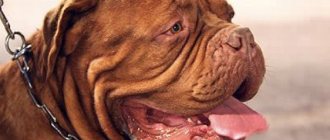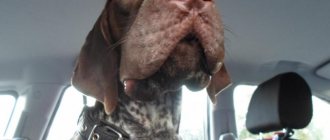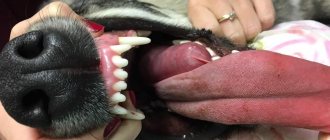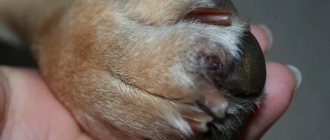by Doctor
Categories:
- Dental treatment
Is it possible to understand that a dog has toothache without going to the vet? Of course, an examination by a doctor is a reliable method, but sometimes dogs suffer from hidden pathologies, which can only be determined through long-term observation.
Behavioral signs
If you have ever had a toothache, you are unlikely to be able to sleep peacefully, suspecting that your pet is experiencing similar discomfort. Typically, the owner's concerns are associated with changes in the behavior of the ward. When there is a toothache, there are some behavioral signs that can help your dog reduce the discomfort.
With any physical ailment, the dog becomes apathetic . Against the background of severe pain, you may notice increased irritability, which “spills out” on family members or other pets. Toothache is long-lasting and can get worse under certain circumstances.
Important! Cold contributes to increased toothache and its exacerbation. If you notice that your pet is trying to warm up, climb onto upholstered furniture and is behaving apathetically, you should look into its mouth.
Toothache accompanies the life of wild dogs almost constantly. Since no one monitors the health of wild and stray animals, at about the age of 2–3 years, four-legged animals begin to have dental problems. As strange as it may sound, the dog adapts to living with this pain. A pet can also hide toothache for a long time, which leads to a worsening health situation.
Note! Toothache rarely causes a dog to completely refuse food or water. If your pet stops eating, it is better to consult a doctor, as the possible problems can be very serious.
- When a dog has toothache, it continues to eat food, but tries not to chew .
- The pet scoops up food with its lower jaw and immediately swallows.
- Chewing food on only one side of the jaw may indicate toothache. On walks and during games, the pet refuses to fetch the toy and stops “brushing its teeth” using sticks.
In the case of pulpitis, a purulent inflammation of the dental canals that affects the dental nerves, the dog will most likely refuse to eat. The pain with pulpitis worsens until the pus that has accumulated in the canals finds a way out.
Option two:
- If the tooth is already destroyed , the canals will break out and pus will come out into the mouth - this is a “favorable” outcome.
- If the tooth is not destroyed and the gums are dense, the pus will go deep into the gums and jaw. After the pus spills, damage to the surrounding tissues occurs, which is called phlegmon.
Of course, it is better not to wait for one or the other outcome, but to consult a doctor. Not all clinics and veterinarians deal with dental problems in dogs. Problems with teeth and gums are solved by highly specialized veterinary dentists. If there are no veterinary clinics in your locality that provide dental care, it is better to remove the diseased tooth. The tooth will sooner or later begin to hurt, but the longer it remains in the oral cavity, the more numerous the colonies of pathogenic bacteria will become.
External signs
Most dental ailments can be detected visually. Almost always, the breath takes on a putrid or sweetish purulent odor.
Pets suffer from a full range of dental diseases and ailments affecting the gums. According to generally accepted rules for keeping pets, a pet's mouth should be examined at least once every three days. You need to pay attention to the condition of the enamel, its whiteness and integrity. Many owners believe that dogs do not suffer from tooth decay, but this statement is far from the truth. If you notice dark spots on your dog's teeth, it is better to immediately contact a veterinarian, since tooth restoration may be possible at this stage.
A toothache in a dog may be indicated by increased salivation and constant slurping of the mouth . When a dog has a toothache, pathogenic bacteria actively multiply in the oral cavity, which leads to gum inflammation. In an attempt to protect the surfaces of the mucous membranes, the salivary glands secrete more saliva, which leads to discomfort in the dog (similar to nausea).
Important! Diseased teeth may appear yellowed or brown. Over time, the diseased tooth is destroyed to the base and turns black. By the time the infection reaches the tooth canals, the dog will already experience pain.
An advanced infection, accompanied by the constant proliferation of pathogenic bacteria in the oral cavity, sooner or later leads to gum damage. The first signs of periodontal disease or similar diseases are a change in the color of the mucous membranes to a more reddish color, swelling and bleeding.
The problem is that even obvious bleeding of a dog’s gums is difficult to notice. When a dog eats, it produces a lot of saliva and the blood oozing from the gums is simply washed away. Bleeding gums can be identified by marks on toys or dried blood particles on the lips after sleep.
Prevention of dental diseases in dogs
In most cases, dental tartar leads to the development of toothache and gum problems. A problem that seems harmless at first glance is fraught with thinning of tooth enamel and the development of pathogenic flora in the oral cavity of dogs.
The problem of tartar consists of a number of factors that are not always obvious:
- Proper nutrition.
- Vitamin content of the diet.
- Regular mouth inspections.
- Teeth cleaning.
- Preventive measures by age.
A dog, regardless of age and breed, should receive both soft and hard food.
- Only solid foods, such as dry food, lead to faster abrasion of the enamel.
- Only soft food does not provide the necessary load when chewing and leads to tooth decay from the inside.
It turns out that for the sake of a dog’s dental health, it is necessary to seek a balance. Like people, our pets need a wide range of vitamins and minerals for the full formation and regeneration of tissues. It is known that teeth are destroyed due to a lack of calcium , but this is a superficial look at the problem. Calcium is not absorbed by the body without magnesium, phosphorus and vitamin C. That is, deliberately feeding a dog with calcium supplements is unlikely to lead to stronger teeth, but it can create kidney problems.
You should always be careful with mineral supplements, as excess salts settle in the kidneys and genitourinary system. Urolithiasis develops in most adult dogs whose diet is not balanced. According to generally accepted rules, a dog’s food should not be salted, since many years of observations have led to the conclusion that table salt not only leads to the development of urolithiasis, but also worsens the dog’s health in general.
Even with ideally selected feeding and regular vitamin courses, with age, the dog develops tartar. You can get rid of it in different ways. For example, preventive teeth cleaning, which a dog should be taught to do from childhood, allows you to get rid of fresh plaque, which turns into stone.
On walks, you may notice that your dog is diligently chewing sticks, this is one of the ways to clean its teeth. At home, you can offer your pet rubber toys or special treats for cleaning its teeth. If the tartar has already become chronic, it is better to consult a doctor and remove it with ultrasound.
Important! Some treats for the prevention of tartar contain technical hydrogen peroxide! Read the ingredients carefully to make sure they are safe.
vashipitomcy.ru
For some reason, many animal lovers naively believe that caries and other dental problems are exclusively human “whims.” But in reality this is far from the case. Our smaller brothers also “successfully” suffer from periodontal diseases. But is it possible to understand that a dog has toothache?
Yes, it's real. But it’s still worth remembering that the dog itself will not be able to tell you what exactly is causing it pain and discomfort: maybe it’s really the teeth. But with the same probability, your pet’s gums may hurt. So all cases of “toothache” should be considered in the context of numerous periodontal diseases.
General information, clinical picture
Firstly, periodontal diseases should not be considered pathologies that are dangerous exclusively for the oral cavity: the bacteria that cause them may well spread throughout the body and cause even more severe pathologies. So we advise you to more carefully observe your pet’s behavior: if you notice something is wrong in time, you can immediately take your dog to the veterinarian.
Contrary to popular belief, you do not need to “stick your head in the dog's mouth” to determine the presence of periodontal disease. Usually everything is much more obvious.
Here are the most typical signs:
- Bad breath. The activity of pathogenic microflora causes putrefactive decay of tissues and provokes inflammatory reactions, which causes the appearance of not the most pleasant “aromas”. However, you shouldn’t expect your dog’s breath to smell “minty fresh,” but a frankly putrid smell is always a sign that something is wrong.
- Inflamed gums. The correct name for this pathology is gingivitis. It manifests itself in the form of swollen, reddened and sore gums. All this is the consequences of the activity of pathogenic microorganisms that rapidly multiply in the oral cavity. They eat leftover food, forming plaque along the way. The latter, getting between the gum and the root of the tooth, causes an inflammatory reaction. This can cause severe toothache, and in some cases, “harmless” gingivitis can lead to degradation of the bone tissue of the dental alveoli and even inflammation of the jaw bone tissue.
- The presence of tartar and plaques on the enamel surface. Dental plaque, which we have already discussed above, with a lack of hard food constantly accumulates on the teeth and the process of its mineralization begins. If nothing is done at all, the teeth become covered with a kind of “crust”, under which various pathogenic microorganisms thrive.
- Flux (swelling and swelling of the muzzle). One of the most visible and typical signs of serious problems with teeth and gums. If the infection is serious, then the gum and all adjacent tissues swell so that it is clearly visible to the naked eye. Sometimes it ends with a slight swelling, and sometimes the dog’s muzzle looks like a well-fed hamster’s face. In the most advanced cases, the abscess eventually bursts and pus begins to flow out profusely. It's hard not to notice this.
- Problems with chewing food. If your dog, who previously had an enviable appetite, suddenly began to eat like a bird, in small portions, then you need to take a closer look at him. If you look closely at the teeth in your dog's mouth, you may notice loose or blackened teeth, or even places where these teeth have broken off at the very root. Putrefactive processes and inflammation in such cases cause severe pain, and therefore the dog, even when trying to touch the tooth that is interfering with it, may behave inappropriately. He will growl, howl, whine, and try to break free and run away.
- Sneezing and rhinitis. These processes may seem to you to be in no way related to diseases of the oral cavity, but this is not so: when there are constant sources of infection in the mouth in the form of rotten teeth and inflamed gums, pathogenic microflora can always get into the sinuses. This is what leads to rhinitis and frequent sneezing.
Dental diseases of dogs. Information for owners.
Periodontitis is an inflammatory lesion of the tissues surrounding the root of the tooth. One of the most common oral diseases in dogs. Characteristic manifestations of periodontitis are the deposition of plaque, tartar, increased bleeding of the gums, the appearance of periodontal pockets, possibly with purulent contents, unpleasant odor from the mouth, and viscous saliva. Periodontitis can be accompanied by inflammation of the submandibular lymph nodes, and in long-term chronic cases, rhinitis (runny nose), heart and kidney diseases. In severe stages, the bone tissue of the jaw surrounding the roots of the teeth dissolves, the teeth begin to loosen and eventually fall out.Periodontitis is a chronic disease, its treatment is long-term and includes antibiotic therapy, removal of tartar and non-viable teeth, and constant local treatment of the oral cavity. The effectiveness of treatment depends on the stage of periodontitis. An important part of treatment is the prevention of more severe stages of the process, so if an animal is diagnosed with periodontitis, it needs constant oral care. Animals prone to tartar formation need to brush their teeth with a special veterinary paste once or twice a week.
The animal should be accustomed to oral hygiene gradually, starting with the incisors (6 small teeth in the middle between the fangs), with each subsequent cleaning increasing the number of teeth treated and the duration of the procedure.
The causes of periodontitis are: hereditary predisposition and the nature of the animal’s diet. Therefore, it is necessary that the animal receives food that needs to be chewed and gnashed for a long time. The peculiarity of bone tissue is that its strength depends on the load on the bone. When the load is weakened or absent, the bone tissue of the jaw, in which the roots of the teeth are located, weakens and partially resolves, this contributes to the further development of the disease. In addition, during prolonged chewing, the teeth are mechanically cleaned. Offer your dog ready-made chewable crunchy toys, there are a lot of these now sold in pet stores, or raw large bones with remnants of meat and tendons. There is no need to wait for the animal to gnaw off the entire bone; remove it some time after the dog eats the cartilage. Such “exercises” must be carried out several times a week.
It should be understood that an animal surrounded by the care of its owners will feel better without teeth than with a chronic inflammatory process in the oral cavity.
They are formed from soft dental deposits (dental plaque), often accompanying periodontitis. When tartar is deposited, an unpleasant odor appears from the oral cavity, the teeth turn yellow or darken, and with extensive tartar deposition, the shape of the tooth may change.
You need to remove tartar under general anesthesia using a special device - an ultrasonic scaler. Animals with a high tendency to form tartar require constant oral care (see above).
Stomatitis is an inflammation of the oral mucosa. The mucous membrane with stomatitis in some areas is red, swollen, covered with ulcers or erosions (ulcers and erosions are also found on the tongue), there may also be purulent deposits, drooling, and bad breath. Stomatitis often develops with periodontitis and can be accompanied by cheilitis - inflammation of the lips. Treatment in this case will include antibiotic therapy, vitamins, and local oral hygiene treatments.
Gingivitis is inflammation of the gums. With gingivitis, owners most often pay attention to the appearance of bad breath, redness and increased bleeding of the gums. The gums can also become inflamed due to the deposition of tartar due to constant exposure to pathogenic microflora.
Periodontal disease
Non-inflammatory damage to the tissues surrounding the tooth root. Due to degenerative processes in the tissues of the gums and jawbone, the necks of the teeth become exposed, and the teeth appear longer. In later stages, they begin to wobble and fall out. This disease is quite rare; periodontal disease is often mistakenly called periodontitis.
Dental caries is rare in dogs. For superficial carious lesions, teeth can be filled; for deep ones, they need to be removed.
If before or during the change of teeth the puppy suffered from an infectious disease or there was an injury in the jaw area, multiple enamel defects may occur. They look like depressions on the tooth enamel, irregularly shaped and gray in color. The disease does not progress over time. There is no data whether this pathology is accompanied by pain. Most likely this is most likely a cosmetic defect. The enamel can be sealed, but in case of multiple lesions this is a long and labor-intensive process performed in several stages.
Change in tooth color
Owners often pay attention to changes in the color of the animal’s teeth. Yellow and brown coloration is most often associated with the deposition of tartar. Pink, bluish, cyanotic coloring occurs due to injury (tooth bruise).
Clinical picture of toothache
But still, what signs can be seen when a dog has a severe toothache (or has another periodontal pathology)?
The symptoms are not very specific, but clearly manifested:
- The dog becomes restless , cannot sit still for a long time, and constantly rubs his face with his paw. On the contrary, some animals lie down, trying not to move and get up only to drink.
- No appetite. But if you carefully observe your pet, it is not difficult to notice that in fact he really wants to eat... but cannot, since chewing causes him severe pain.
- If you try to palpate the jaw or examine your pet’s teeth, he may behave inappropriately and show aggression (as we already wrote about above).
Injections
Injections are the best option for pain relief. They do not affect the gastrointestinal tract, and the effect is achieved in a short time. In addition, the owner is sure that all the medicine was injected during the injection - unlike tablets, solutions cannot be spat out.
The downside is that you need to know how to give injections. And sometimes animals struggle so much that it is impossible to administer the solution.
Ketonal
The best medicine for people that can be used by animals. Ketonal relieves severe pain, it has few side effects - sometimes vomiting and diarrhea are observed. In addition, it is inexpensive - 200-300 rubles.
How to care for your pet
If you notice any of the symptoms described above, take your pet to the vet immediately. He will not only conduct a general medical examination of the animal, but will also take all the diagnostic tests necessary in such cases. It is possible that your dog's strange behavior is not due to dental disease, but to something else.
Since quite predictable problems can arise with a visual examination of a dog’s teeth, veterinarians in many cases immediately resort to x-ray examination of the jaw. This technique will allow you to identify areas of destruction of dental tissue, cavities and other pathological formations.
After this, the specialist (most likely after administering powerful sedatives) will scrape away plaque and tartar to localize the area of destruction of dental tissue. It is preferable when high pressure water is used for this purpose. It not only cleans your teeth, but also washes away all the dirt. In addition, many specialists in this case take tissue samples to determine the specific causative agent of the infection.
As a rule, when they detect foci of destruction of dental tissue and advanced cases of caries, veterinarians prefer to immediately remove the affected tooth. And it’s not a matter of laziness or unwillingness to put fillings. Dogs have a fairly thin layer of enamel and a fragile tooth structure. Of course, filling can be done, but there is no guarantee that it will last for any long time.
Abroad, dental crowns are used in veterinary dentistry, but even there this service is not in great demand due to its high cost. So in 90% of cases, the diseased tooth is removed, and the empty hole in the gum is stitched up. To avoid possible infection, the dog is prescribed a course of antibiotics. And we would not recommend skipping their doses, since in this case the development of sepsis is possible.
Prevention
To prevent pathologies of teeth and gums, you can regularly brush not only your own teeth, but also your dog’s. For this purpose, it is advisable to use specialized pastes and brushes created specifically for animals. This must be done daily, otherwise there will be no special effect. The inside of a dog's mouth does not need to be cleaned.
Note: DO NOT use human toothpaste on your dog's teeth. These products contain many substances that are dangerous to the health of the digestive system of animals! If you don’t have a special paste, use a soda solution.
zveridoma.ru
Dogs rarely have toothache. And you can understand that this is exactly the problem by the pet’s constant shaking of its head and its “crying” while eating.
Also, if you look closely, you will notice that the dog is gnawing treats on only one side of its jaw. If this occurs, then you need to conduct an independent inspection of the mouth. You need to look for swollen gums, a tooth damaged by caries or periodontal disease. Diseased teeth, as a rule, begin to turn yellow, and an unpleasant odor appears in the mouth.
Inflammation of the gums , as in humans, can be caused by formed stones and plaque. If you don't treat your pet's teeth, he will lose them. Moreover, in dogs, stones can be located above and below the gum. If it flaunts above the gum, then inflammation is inevitable. It is very difficult to detect a stone under the gum on your own. But after some time his presence will become noticeable to the same sign. It's all about the proliferation of bacteria that cause irritation of the gums. Tooth decay in dogs most often begins if the pet has suffered from distemper. It is a putrefactive decay of dental material.
The tooth pulp can also become inflamed , then we are talking about pulpitis. These are the consequences of caries or tooth fracture. Simply put, the pulp is exposed. Then the process moves on to the tissue and tooth root. The first sign of the disease is a change in the color of the enamel.
Periodontitis refers to inflammatory processes in the tissue around the tooth. This is most likely in the presence of cracks, bruises, and inflammation of the gums.
In all cases, the pet owner must act in exactly the same way as if toothache was tormenting him. This means you need to immediately contact a veterinarian. Only he removes stones. To do this, the mouth is washed with an antiseptic for 5 days in a row, several times. A potassium solution or lactic acid is suitable for this. In case of caries, the diseased tooth is washed with sodium fluoride (4%). If these measures do not bring results, the tooth is still removed. The same applies to lesions from purulent pulpitis. If you have pulpitis, your pet should be fed soft food and the area around the tooth should be lubricated with glycerin.
To prevent such a thing from happening to your pet, be sure to have its mouth examined once every six months. After the animal reaches 3 years of age, tartar should be removed periodically. This is especially true for older dogs. In any case, the pet’s diet must be properly balanced according to all the veterinarian’s recommendations, taking into account the characteristics of the breed.
Author: Chernigovskaya A.A.
sobakino.com
Dental diseases are not uncommon in dogs. Most often, you can understand that a dog has toothache by the fact that it often shakes its head and also whines while eating.
She tries not to chew on one side. In this case, you need to look into the dog’s mouth and examine it. You can see swollen gums near the diseased tooth, as well as a damaged tooth with caries or periodontal disease. Also, an unpleasant odor appears from the dog’s mouth, and the teeth turn yellow.
Effective painkillers for dogs: list, instructions for use and reviews
Sometimes our pets need help. They can also get sick, get a fracture, dislocate a joint, and so on. We do not always rush to alleviate the suffering of our friend, thinking that the illness will go away on its own. But in some cases, pain relief for a dog is simply necessary. In this article we will figure out what you can give to your pet, and what is strictly prohibited.
How to understand that pain medication is needed
The most important rule for handling medications for animals is to never decide on your own the issue of their use. The fact is that many drugs intended for people can be real poison for dogs.
Moreover, often after their adoption there is not even time left to save the animal. Therefore, before using painkillers on your dog, consult a specialist. There are hospitals and veterinary pharmacies in cities, many of which are open 24 hours a day.
Painkillers for a dog should be prescribed by a doctor based on the pet’s health condition, the degree of pain and injuries sustained. If you are concerned that your dog is feeling unwell, is not eating or drinking well, is not moving much, is whining or hiding, feel free to contact your veterinarian.
Types of Painkillers
Painkillers for dogs come in different types and modes of action. Each type is designed for a specific symptom and source of pain. The following types of drugs are distinguished:
- Nutraceuticals are pain relievers for dogs made from natural ingredients. The composition includes various fats of plant or animal origin, amino acids, vitamins, minerals, antioxidants. This type is considered the safest and most harmless for animals. Such drugs have virtually no side effects, and they are prescribed mainly for joint pain.
- Non-steroidal anti-inflammatory drugs. Reviews from dog owners say that these are more effective drugs. They relieve pain much faster than nutraceuticals. These include Ibuprofen, Aspirin, Neproxen. However, if the dosage is incorrect, it can cause vomiting, diarrhea, lethargy and lack of appetite.
- Steroid medications are also prescribed to dogs to relieve pain. However, they have an even longer list of possible complications, and their independent use is strongly discouraged.
- Narcotics and opioids are used in the most extreme situations. Such painkillers for dogs are indicated, for example, during urgent surgical interventions.
Specialized products for dogs
There are not many specialized pain medications for dogs on the market. Veterinary pharmacies are limited to a list of four items. These are Novox, Rimadyl, Deracoxib, Meloxicam. All of them are non-steroidal drugs.
Dog breeders note that such medications practically do not cause side effects when used correctly.
However, in special cases they can cause digestive problems, diseases of the gastrointestinal tract, kidneys, peptic ulcers, and so on.
It is up to the veterinarian to decide what pain reliever can be given to the dog. The following names can be found in veterinary pharmacies for steroid drugs for four-legged animals: “Amantadine”, “Gabapentin” and “Tramadol”.
“Rimadyl”
It has an analgesic effect, relieves inflammation and fever. Prescribed to animals with acute diseases of the musculoskeletal system (arthritis). It is often used in the period after surgery to prevent inflammation and relieve swelling. The daily dose for an adult animal is 40 mg per kilogram of body weight.
The dose is divided into two doses, a week after the start of the course it is halved. Two weeks after the start of the course, the dog must be examined by a doctor. Owners of four-legged animals claim that there are practically no side effects from the drug, but occasionally irritation of the mucous membranes and vomiting may occur.
The dog may have an individual intolerance to the main active ingredient.
Do not give the drug to pregnant bitches and puppies. Prescribed with caution if the animal has liver, kidney or heart disease. The cost of a bottle with thirty tablets ranges around 800-900 rubles. Reviews of the drug note that after taking it, the animal may experience diarrhea. In this case, the medicine should be discontinued.
"Meloxicam"
The drug is available in the form of a suspension for oral use. Trade name: Loxicam. It has a pronounced analgesic, antipyretic and anti-inflammatory effect.
Painkillers are prescribed for dogs of all breeds and cats for chronic pain in the musculoskeletal system (arthritis, arthrosis, dislocations, fractures), for damage to soft tissues, and in the postoperative period.
Not for use in pregnant or lactating females, puppies and kittens under six weeks of age, or in cases of dehydration. The drug is given to animals once a day during feeding. On the first day, give 0.2 mg per kilogram of animal weight, on subsequent days - 0.1 mg.
Steroid drugs for dogs
What painkillers can be given to a dog is determined by a veterinarian. Steroid medications are prescribed quite rarely, since they are often unnecessary or the side effects are so undesirable that the use of the drug is impossible. These include the following pain relievers for dogs:
- "Amantadine" - helps block pain. For dogs, it is prescribed as a treatment for arthritis, various spinal diseases and cancer. Diarrhea is often observed with its use.
- “Gabapentin.” It is used for pain resulting from damaged nerve endings. Causes drowsiness in the first few days of use, then the dog gets used to this effect. It is usually prescribed as part of a combination of medications.
- Tramadol is a mild pain reliever. This drug is prescribed to older dogs that experience chronic illness due to age.
Action in emergency situations
If local use of analgesics is required, Ledocaine is used. The preferred dosage form is a spray. In an emergency situation (for example, a fracture), when there is not a single veterinary pharmacy nearby, the dog can be given a regular Analgin tablet.
The calculation is made based on the ratio of one tablet per twenty kilograms of weight. Under no circumstances should dogs be given the following types of medications: Diclofenac, Ketorolac, Indomethacin.
For dogs, they are a deadly poison, cause severe damage to the liver and digestive system, and affect the nervous system.
Source: https://FB.ru/article/246032/effektivnyie-obezbolivayuschie-dlya-sobaki-spisok-instruktsiya-po-primeneniyu-i-otzyivyi
Common dental diseases in dogs
First of all, this is the formation of plaque and stone, which always lead to gum inflammation. As a result, the tooth falls out. Tartar in dogs can be supragingival or subgingival. If it is located above the gums, gingivitis may occur - inflammation of the gums.
It is difficult to see the stone under the gums, but it still supports the growth of bacteria and irritates the gums. Caries is putrefactive decay of the tooth substance. Often develops in dogs after suffering from distemper.
Inflammation of the dental pulp is called pulpitis. It occurs when the pulp is exposed due to caries or tooth fracture. Then the process moves on to the tissues that surround the root. With pulpitis, the tooth changes color. Periodontitis is an inflammation of the tissues that surround the root of the tooth. Occurs when cracks, bruises and inflammation of the gums spread to the tooth and it becomes loose.
What to do if your dog has a toothache: necessary treatment and prevention
The tartar must be removed by a doctor. Then the animal’s oral cavity is washed with antiseptic solutions a couple of times a day for 4-5 days. For example, a solution of potassium permanganate. Can be lubricated with lactic acid and treated with a 3-5% solution of baking soda.
For superficial caries, you can treat the tooth with a 4% solution of sodium fluoride or a 3-5% solution of silver nitrate. In other cases, the tooth is removed. If there is pulpitis around the neck of the tooth, you need to apply iodine-glycerin and feed only soft food. A tooth affected by granulomatous, purulent or gangrenous pulpitis must be removed.
To treat periodontitis, the oral cavity is washed with warm disinfectant solutions (furacilin, potassium permanganate, 3% sodium bicarbonate, 3% boric acid). You can also use:
- salvin,
- propolis,
- camphomenes,
- sage decoction,
- pharyngosept.
The dog is given soft food. For pulpitis and periodontitis, calendula (medicinal marigold) is a good treatment. Rinse the mouth with its infusion. Pour 10 g of flowers with a glass of boiling water and infuse. Before use, dilute a teaspoon of tincture into a glass of warm water. You need to rinse morning and evening.
dogsecrets.ru
Doctor
What to do and how to help the animal?
Suspecting a dental problem, the owner wants to know what to do if the dog has toothache. First of all, you need to turn to professionals. A veterinarian will conduct a visual examination of the furry patient’s jaw and identify the disease. In some cases, the animal may require light sedation for a full examination.
Dental services
Modern veterinary medicine allows us to provide four-legged patients with a wide range of dental services. If tartar is detected in an animal, a qualified specialist will perform ultrasonic cleaning. An effective procedure allows you to remove hard plaque, which reduces pressure on the soft gum tissue and helps improve the health of your pet’s oral cavity. The manipulation is carried out using painkillers.
In addition to cleaning teeth from plaque, veterinary dentistry widely uses the removal of damaged canines and incisors. Professionals know how to help if a dog has toothache due to deep caries or pulpitis. In such advanced cases, a veterinary specialist, as a rule, removes the damaged teeth, relieving the furry patient of pain.
In specialized clinics in megacities, high-tech techniques for filling dental canals are available to owners of furry clients.
Treatment with antibiotics
In some cases, a sick pet does not require such drastic measures as tooth extraction, and the doctor prescribes conservative treatment. Thus, for periodontitis and periodontal disease, animals are prescribed disinfectant solutions. They are used warm to irrigate the oral cavity. For this purpose, antiseptic solutions of furatsilin, potassium permanganate, boric acid and soda are used.
Decoctions of chamomile, sage, and calendula have a good anti-inflammatory and calming effect.
To disinfect soft tissues in veterinary dentistry, ointments based on propolis and metronidazole are used. If your dog has a toothache, it can be treated with antibiotics. This therapeutic approach is effective if toothache is caused by inflammatory processes in the oral cavity. In this case, a veterinarian can use antimicrobial agents both locally and in the form of intramuscular injections.
The general use of antibiotics is advisable for severe gingivitis, complicated pulpitis, and periodontitis.
Watch this video about how to treat a dog's teeth:










